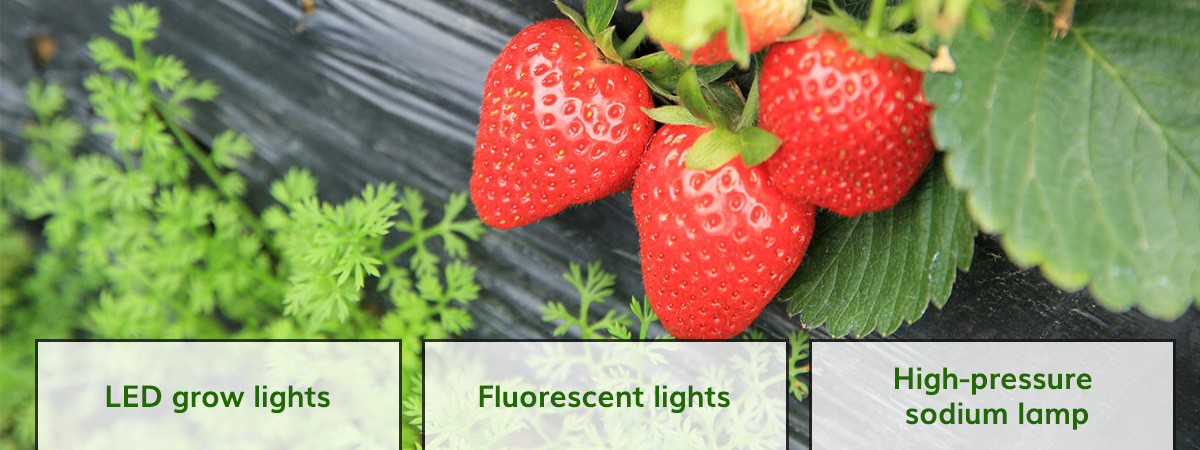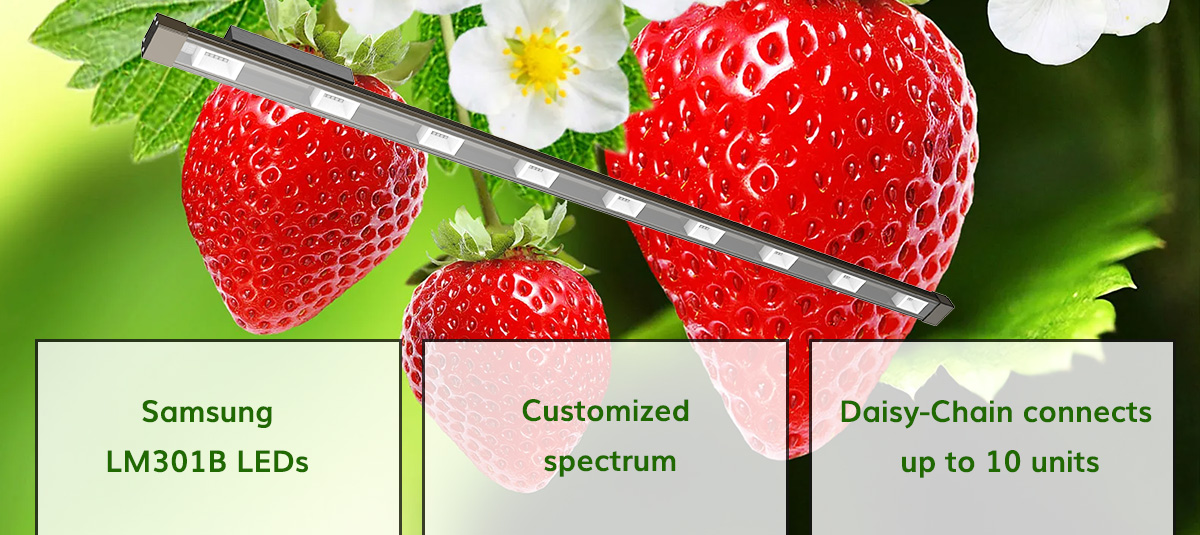Growing strawberries has become a popular trend around the world, with this delicious and nutritious fruit being favored on both commercial farms and home gardens. However, successful strawberry growth relies heavily on adequate and suitable light – a factor that is often overlooked. As technology advances, grow lights are ideal for making up for the lack of natural light and optimizing strawberry growing conditions. This article will explore why choosing the right grow lights is crucial to growing high-quality strawberries.
Light requirements for strawberry growing
Strawberry is a plant with special needs for light. It needs sufficient sunlight to ensure good growth and fruit development. At different growth stages, strawberries have different light needs.
In the seedling stage, strawberries need blue light to inhibit stem elongation and promote thick stems and thick leaves. Light during this period is crucial to establishing the growth foundation of the plant. Proper lighting not only promotes the healthy growth of seedlings, but also prevents them from growing too thin, laying a solid foundation for their subsequent flowering and fruiting.
Entering the flowering stage, strawberries have an increased need for red light, which helps promote the formation and opening of flowers. At this time, the lighting needs to simulate long-day conditions in summer to promote the strawberries to enter the fruiting stage. The right combination of light duration and spectrum can significantly affect the quantity and quality of blooms.
During the fruiting and ripening period, continuing to provide sufficient red light can help promote rapid ripening of the fruit and increase the sugar content, making the strawberries sweeter. At this time, the lighting should simulate the lighting conditions of fruit ripening in the natural environment to ensure that the fruit is evenly ripe and rich in nutrients.
What are the advantages of using grow lights to grow strawberries?

First of all, the light provided by the grow lights can meet the needs of strawberries very precisely, which means that the light conditions can be controlled all year round, regardless of changes in the external environment. This continuous and stable light environment is conducive to maintaining a consistent growth cycle of strawberries, thereby increasing yields.
Secondly, by using plant lights, we can control the length of light. Such fine control can help optimize the growth status of strawberries, promote their healthier growth, increase the sugar content of the fruit, and improve the quality of strawberries.
In addition, the use of plant lights can also reduce strawberry's dependence on natural conditions and reduce growth risks caused by weather changes. For example, in rainy days or winter, when natural light is insufficient, plant lights can ensure that strawberries continue to photosynthesize and maintain growth speed and yield. This independence from environmental conditions makes strawberry growing more flexible and controllable.
During the fruiting and ripening period, continuing to provide sufficient red light can help promote rapid ripening of the fruit and increase the sugar content, making the strawberries sweeter. At this time, the lighting should simulate the lighting conditions of fruit ripening in the natural environment to ensure that the fruit is evenly ripe and rich in nutrients.
What are the advantages of using grow lights to grow strawberries?
First of all, the light provided by the grow lights can meet the needs of strawberries very precisely, which means that the light conditions can be controlled all year round, regardless of changes in the external environment. This continuous and stable light environment is conducive to maintaining a consistent growth cycle of strawberries, thereby increasing yields.
Secondly, by using grow lights, we can control the length of light. Such fine control can help optimize the growth status of strawberries, promote their healthier growth, increase the sugar content of the fruit, and improve the quality of strawberries.
In addition, the use of grow lights can also reduce strawberry's dependence on natural conditions and reduce growth risks caused by weather changes. For example, in rainy days or winter, when natural light is insufficient, plant lights can ensure that strawberries continue to photosynthesize and maintain growth speed and yield. This independence from environmental conditions makes strawberry growing more flexible and controllable.
Finally, the use of grow lights can make strawberry planting no longer subject to geographical and seasonal restrictions, enabling year-round planting and harvesting. This has significant economic value for producers who need to supply fresh strawberries to the market at specific times. By precisely controlling light conditions, strawberries can be ensured to always be in optimal growth condition and meet the market's demand for high-quality strawberries.
Types and selection of grow lights
Plant growth lights are artificial light sources designed to simulate natural lighting conditions, and mainly include LED lights, fluorescent lights, and high-pressure sodium lights.
LED grow lights: LED lights are known for their high energy efficiency, long life and low heat generation. It provides a spectrum suitable for strawberries, promoting strawberry growth and fruit ripening. LED lights generate low heat and can reduce water evaporation, making them suitable for controlling the temperature and humidity of the strawberry growing environment.
Fluorescent lights: Traditional fluorescent lights are another option for growing plants, especially for strawberries in the seedling stage. Fluorescent lights offer a broad spectrum that mimics the effects of natural light and promotes healthy growth of seedlings. However, they are generally less energy efficient than LED lights.
High-pressure sodium lamp: High-pressure sodium lamp emits strong yellow to orange light, suitable for use during the flowering and fruiting stages of strawberries. They promote rapid fruit ripening, but due to their high calorific value require careful management to avoid damage to the plant from excessive temperatures.
For strawberries, since they require sufficient and balanced light throughout their growth cycle, LED grow lights are the first choice due to their high energy efficiency, long life and low heat generation.
Why use 50W waterproof LED tube?

After exploring the many advantages of using grow lights to grow strawberries, you may be asking, which grow light best meets these needs? Our 50W waterproof leafy vegetable planting light may be the answer you are looking for.
Want to know why this light is so great for growing strawberries? First of all, considering the quality of the light source, this lamp uses original Samsung LM301B LEDs to provide high-quality, stable lighting, which is crucial to meeting the strawberry's delicate needs for light quality. Moving on to installation flexibility, the variety of installation options we offer ensures easy adaptation regardless of the growing environment, allowing for simple maintenance and replacement.
So, what about customization requirements? We can customize the spectrum according to your needs to provide the best growing environment for your plants. Moreover, considering the possibility of large-scale planting, our Daisy-Chain function can connect up to 10 lamps to achieve uniform illumination over a large area. In addition, taking into account the diversity of planting environments, our IP65 waterproof rating ensures that the lamps can be used safely in most planting facilities.
Finally, are you concerned that the product won’t fit your specific grow project size or shape? Our optional length customization service ensures that the fixtures can be customized to the specific needs of the project, whether it is a small-scale home cultivation or a large-scale commercial production, to get a perfect match.
So, when thinking about choosing the right grow light for strawberry growing, why not choose one that covers all aspects of your needs? Our 50W waterproof leafy vegetable planting light tube is designed to improve the efficiency and yield of your strawberry planting. Click below to contact us now and start your efficient planting journey!























